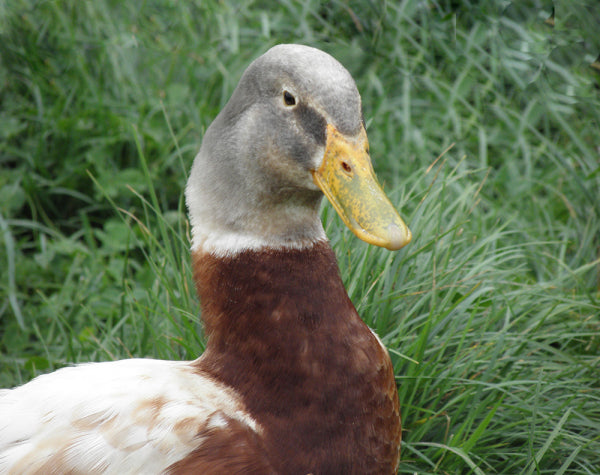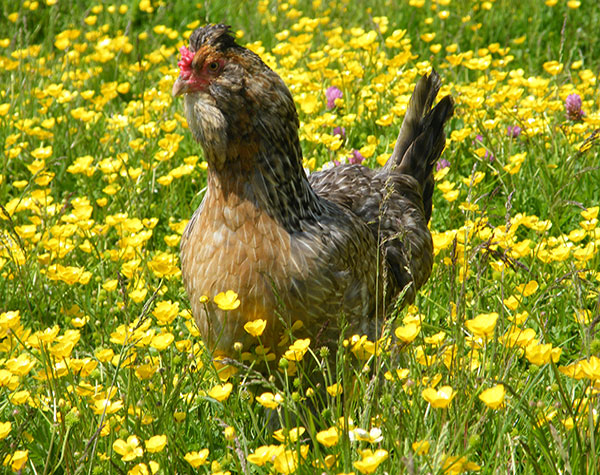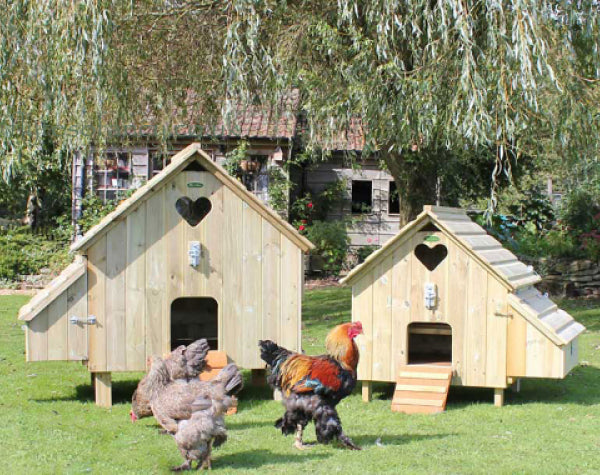An Introduction to some popular Duck Breeds in the UK

Ducks come in many shapes and sizes, from the Mallards that we see swimming up and down our ponds and rivers, to the upright stance of a Runner Duck hurtling across a garden.
Seen here are some of our collection of Ducks at Flyte so Fancy - mainly Cayugas, Appleyards, Mallards and Cherry Valley.
They also, like chickens, can have a wonderful range of colour in their feathers and the crested duck with his pom-pom like hairdo is a wonderful example of how varied ducks can be.
Below is a list of some of the more common breeds that people keep as back garden waterfowl.
- - -
CALL DUCK

The smallest of duck breeds, it also happens to be the noisiest, as its name suggests.
Originally imported from America, their long persistent quacking was used by British keepers to "call-in" wild ducks for shooting.
Being a small bird, Call Ducks only require a shallow tray for their bathing and due to the stubby nature of their bills need feeders and drinkers that are low to the floor.
If you have neighbours that are particularly close by, you may wish to consider them, as Call Ducks really are loud quackers.
Call Ducks are ideal for children as they are relatively tame, small and do not mind being handled.
- Type: Bantam Duck
- Eggs: 50 - 150 white eggs per year
- Colours: Predominately white
- - -
BLACK EAST INDIAN DUCK

The beautiful green iridescence of their feathers makes the East Indian a stand out show bird.
One of the oldest breeds of bantam ducks it is genetically related to the Cayuga.
An excellent forager when left to wander, the black feathers of the East Indian Duck shine iridescent green when in the sunshine.
As the birds grow older, the females develop white patches in their feathers, just like going grey from old age.
- Type: Bantam Duck
- Eggs: 40 - 100 white eggs per year
- Colours: Black feathers that shine green. The females develop white feathers as they age.
- - -
CHERRY VALLEY
 Cherry Valley ducks are a domesticated 'hybrid' (commercial) bird created by crossing a Pekin with a Rouen and was developed by Cherry Valley Farms (UK) Ltd. They are world leaders in Pekin breeding stock and created the Cherry Valley brand which is the commercial name for this duck.
Cherry Valley ducks are a domesticated 'hybrid' (commercial) bird created by crossing a Pekin with a Rouen and was developed by Cherry Valley Farms (UK) Ltd. They are world leaders in Pekin breeding stock and created the Cherry Valley brand which is the commercial name for this duck.
The birds are bred to be good egg layers, and a good meat bird as they mature within 10 weeks.
They are hardy and friendly ducks making them easy to care for and a popular choice for backyard keepers as well as commercial producers.
FSF has a resident flock of 8 Cherry Valleys whose plump white bodies waddle their way around the paddock usually in a long line along on a well trodden path to the pond.
- Type: Hybrid Heavy
- Eggs: 150-200 eggs per year
- Colour White with orange legs and bill
- - -
INDIAN RUNNER

Instantly recognisable for their upwards stance and shuffling gait, Indian Runner ducks are happy to spend most of their time on land foraging as opposed to splashing around in the water.
As such they only need a large tub of water in which to submerge their heads and dabble, making them ideal ducks for the back garden keeper.
Originating in the East Indies, they are excellent egg layers and top-notch foragers.
Their original use in Asia was to be driven into the paddy fields where they would then clear them of slugs and insects, before being rounded up in the evening.
Built for covering great distances, the Indian Runner Duck is a great breed for the back garden.
- Type: Runner
- Eggs: Around 200 eggs per year
- Colours: Multiple colour options are available
- - -
KHAKI CAMPBELL DUCK

Originally bred in Gloucestershire by Mrs Adele Campbell in 1901, the aim was to create an exceptional egg layer. She used a Rouen Drake and a fawn Runner Duck (with a little Mallard blood too).
Mrs Campbell was successful, and the Campbell duck is popular with many smallholders and back garden keepers today for its laying ability.
Also designed to be a good meat bird, when purchasing a Campbell make sure that it has not been bred for exhibition, as its egg-laying powers will have been reduced.
An excellent utility bird for those looking for an all-round egg layer.
- Type: Light
- Eggs: 250 to 300 + eggs per year
- Colours: Khaki, White, Dark
- - -
WHITE CRESTED DUCK

The origins of the Crested Duck are unsure, however, it is most likely that Crested Runner Ducks from Bali, were crossed with local ducks in Holland, resulting in this pom-pommed duck.
Crests can occur on Mallards naturally and it is through selective breeding that Crested Ducks have been created.
The mutation causes a lethal result if two crested ducks are bred together, causing health issues in the young and 25% of eggs not making it past the embryonic stage. As such Crested Ducks should be bred with a different breed of duck. Or, of their offspring, some will be crested, some will not.
- Type: Light
- Eggs: 120 to 200 eggs per year
- Colours: White or coloured
- - -
AYLESBURY DUCK

Originating from the town of Aylesbury in the early 18th century, the Aylesbury Duck was bred for its meat. They were known for the flavour of their meat and the best table duck for London markets. Its feathers were equally desired for quilts and bedding.
The ducks are known for being hardy so were walked the 40 miles from Aylesbury to London. The ducks were walked through tar and then sawdust to protect their feet, stopping overnight halfway.
One of the best table breeds, after suffering hybridisation in recent years, nowadays not all white ducks are Aylesbury ducks.
True Aylesburys are heavy, broad-brested birds with distinctive white feathers and orange legs and feet. Many ducks sold as Aylesbury Ducks are in fact hybrid crosses, so double check when purchasing.
- Type: Heavy
- Eggs: Up to 200 eggs per year
- Colours: White feathers with a distinctive orange bill and legs
- - -
ROUEN DUCKS

Originating from the Rouen region of France, hence its name, its colouring and marking closely resembles that of wild Mallards.
The Rouen is extremely slow-growing, taking nearly a year to reach its full size, meaning it has lost favour commercially.
A docile and calm duck, it was originally used as a meat bird, due to its stocky body as it is not a very good egg layer. However, nowadays it is more likely to be seen at exhibitions. Its eggs have a green tinge to their colouring.
- Type: Heavy
- Eggs: Up to 150 eggs per year
- Colours: Wild Colour, Blue, Apricot
- - -
SAXONY DUCKS

A heavy breed of Duck originating in Germany in the 1930s. It wasn't recognised as a breed in the UK until 1982.
The Saxony Drake has a distinctive grey-blue hood, white neck ring and a chestnut coloured breast.
The female is plainer shades of light brown colour with white stripes on each side of her face. The breed is a fairly relaxed one.
Its primary use is as a meat bird, but thanks to its striking feathers are often shown at exhibitions.
- Type: Heavy
- Eggs: Up to 100 eggs per year
- Colours: Grey and Buff with orange legs
- - -
CAYUGA DUCKS

Taking its name from Lake Cayuga in New York State, the Cayuga Duck has wonderful black feathers that shine iridescent green when the sun shines upon them.
As with other black ducks, like the Black East Indian, the females will develop white feathers as they age.
A good utility bird, the Cayuga is good for both meat and its first eggs when laid can be very dark, almost black in colour, but this fades over subsequent lays.
- Type: Heavy
- Eggs: 80 to 160 eggs per year
- Colours: Black feathers that shine green in the light
- - -
SILVER APPLEYARD DUCKS

Created by Reginald Appleyard in Suffolk in the 1930s, the Silver Appleyard was bred to be both a good table bird and an excellent layer. Silver Appleyards grow very quickly.
Capable of producing a 3kg table bird in just nine weeks and are also one of the first birds to start laying in the year.
Active foragers, compared to other breeds of heavy duck, lay large white eggs, but do have a tendency to go broody.
- Type: Heavy
- Eggs: 100 to 180 eggs per year
- Colours: Silver
- - -
PEKIN DUCKS

The Pekin Duck is one of the best birds for producing meat for the table and is to be found on Chinese menus everywhere. It produces tender high-quality meat from 8 weeks old.
Originating in China, the European Pekin has a far more upright stance than other variations.
The Pekin has very soft white and cream feathers and a bright orange bill and feet.
The soft nature of its feathers means too much mud should be avoided and if you are looking to breed these birds, they do require deep water.
- Type: Heavy
- Eggs: Up to 140 eggs per year
- Colours: Cream / White
- - -
MUSCOVY DUCKS

'Muskys' are very large but calm and docile. A rather unique duck, originating in South America, they are hardy and good for back garden keepers. The Musky is the only domestic duck not to be descended from the wild Mallard.
It is actually a perching duck and has sharp claws on its feet to allow it to perch well, they can give a nasty scratch too.
A unique looking duck with its bright red eye masks on the head, with fleshy lumps (caruncles), and a hooked black bill. A good egg layer but it often goes broody and will sit perhaps two or three times a year.
- Type: Heavy
- Eggs: Around 150 eggs per year
- Colours: Blue, Chocolate, White, Lavender, Wild, Magpie
- - -
GETTING YOUR DUCKS IN A ROW

- - - -
Image credits: Mainly Flyte so Fancy's own, and various images collected over years from customers or long-forgotten unnamed sources.
Deciding on Your Ducks ©Flyte so Fancy 2014. Updated 2021 and 2022. Author: Anne Weymouth (Director, Flyte so Fancy Ltd). Reproduction of part or all of this text is only possible with the express permission of Flyte so Fancy Ltd



